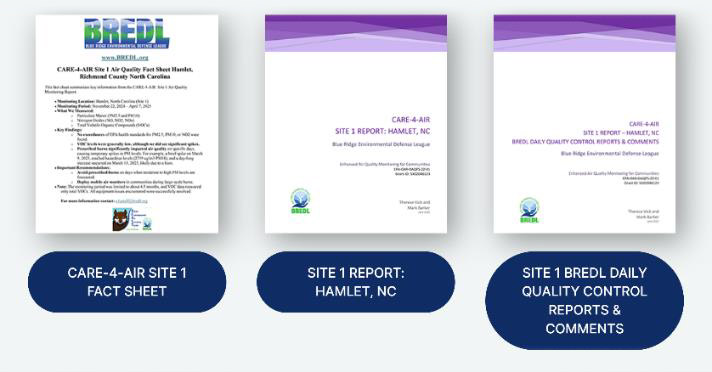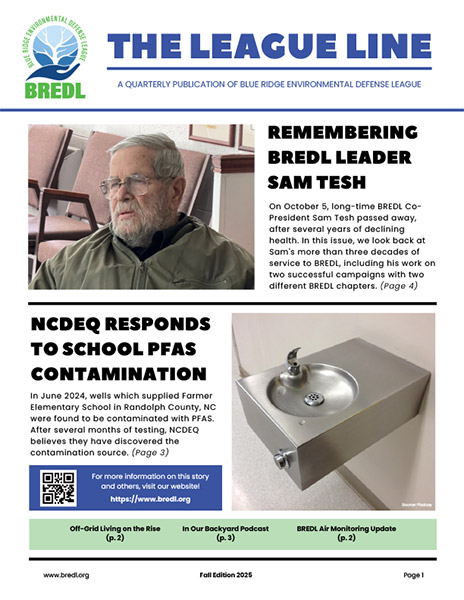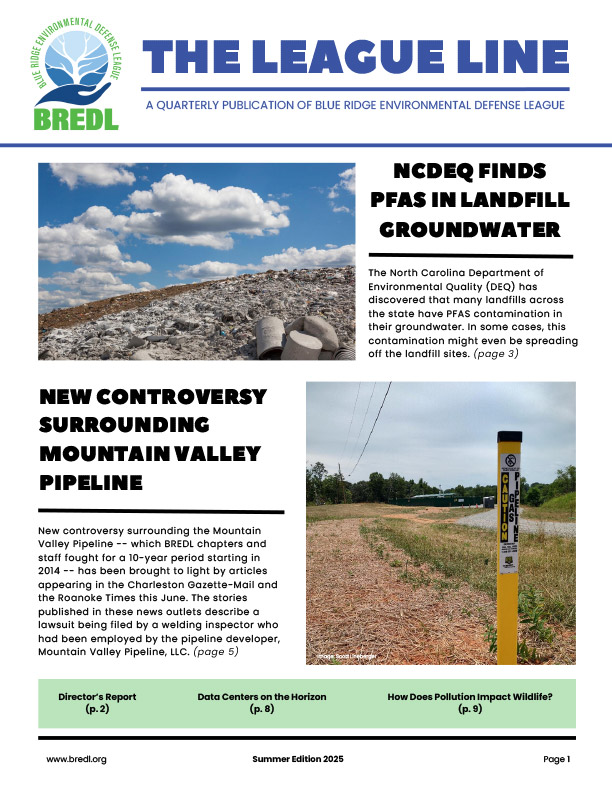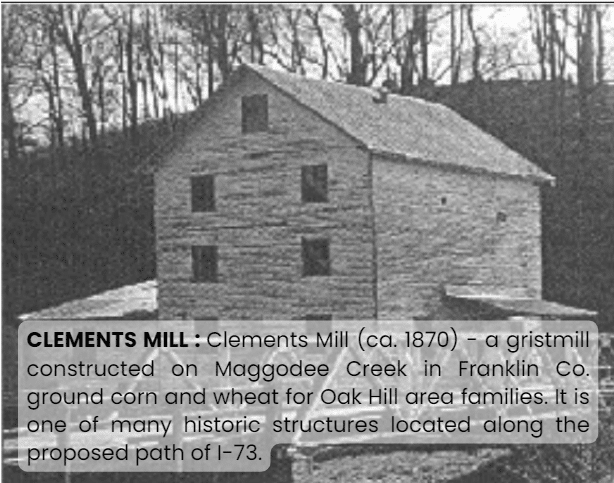-
BREDL Releases Site 1 Air Monitoring Findings for EPA-funded Care4Air Project

Blue Ridge Environmental Defense League (BREDL) has completed our air monitoring at a site in Hamlet, North Carolina, which is in Richmond County. The monitoring period was November 22, 2024, through April 7, 2025. The air monitoring trailer, known as the B.E.A.S.T. (BREDL Environmental Air Sampling Trailer) is equipped with state-of-the art equipment.
Our Site 1 report details our findings and provides information on the facilities near the site, as well as activities that could impact air quality in the community. There is an accompanying report which gives additional technical information. “We are adamant about informing the public of hazardous toxins in their communities. Our Care 4 Air project is extremely important when it comes to the health and welfare of the communities we serve across the Southeast,” said Kathy Andrews, Executive Director of BREDL.

Links to site reports can be found here.
The BEAST has been moved to Site 2 where it is currently monitoring the air. The Care4Air project was made possible through a grant from the Environmental Protection Agency.
BEAST video footage for media use can be found here. BEAST photos available upon request.
-
Community Empowerment Through Economic Resilience

In December of 2023, Michael Savino and members of BREDL’s NoMEC chapter spoke out against rezoning more than 400 acres of land from “rural conservation”, to “general industrial”. Enbridge has proposed a 50 million gallon liquified natural gas storage facility at the site. A newly formed group of community members and nonprofits is seeking to help Person County, NC create a more vibrant and resilient economy. The group originally formed after Person County resident Michael Savino spoke out at a public hearing on the rezoning for the proposed Moriah Energy Center. Savino identified the need for local residents to develop their own plan for economic development that serves residents and uplifts community strengths without jeopardizing health, safety, or the rural character of the area.

The group defines economic resiliency as a community’s ability to cultivate good jobs, quality of life, and essential services, despite changing conditions, as well as to adapt to stressors and leverage new opportunities. In December, the group which includes community members, Blue Ridge Environmental Defense League, Appalachian Voices, North Carolina Black Alliance, and Down Home North Carolina, held a listening session to learn more about how Person County residents felt about the county’s economy. At that time citizens expressed frustrations about past local economic development efforts, particularly those that may have harmed the environment or neglected marginalized populations.
On February 4th the group, now known as the Partnership for a Strong Rural Economy (PSRE), held a community listening session to hear what ideas residents have for solutions. Common themes of the meeting included bolstering the agricultural economy in the county, supporting small businesses, expanding recreation opportunities, and training community youth for their future endeavors.
Savino, who also serves as one of the local organizers, said that he felt the session was productive. “What I saw there was a passionate group of people from many backgrounds and from many parts of the county coming together because they care so much about the county, and especially about our youth, wanting our young people to thrive right here in Person County.”
“I see how important it is for us to come together to share our passions, our dreams, our ideas. We need each other. Together, we can create a vibrant, healthy, thriving community, and enjoy the rich friendships that develop as we work together,” said Savino.
The group plans to hold more of these sessions throughout the year. Residents will have opportunities to learn about what other communities are doing and to take site visits to other successful projects. Brayndon Stafford, of North Carolina Black Alliance is hopeful that the meetings will leave the community more informed and feeling empowered.
“We are at a pivotal time in history where it’s more important than ever for communities to have a direct hand in the shaping of its future. Fortunately, oftentimes the work of a few can garner the impact of many. PSRE has intentionally worked to provide insight and education to Person County residents in order to engage in positive community development. This group took the initiative to engage the community with informative sessions to help residents, in the light of the challenges they may face, to understand their power and agency in shaping what a future Roxboro would look like for them.”
If your or your organization is interested in participating in these ongoing discussions, please contact Jason Torian at (336) 439-5660.
-
BREDL Announces Deployment of “The B.E.A.S.T.”

THE BEAST UNLEASHED: The BREDL Environmental Air Sampling Trailer has been delivered to our first location and will be deployed to other sites in the Southeast over the next three years. Blue Ridge Environmental Defense League (BREDL) has officially launched our community air monitoring project featuring the B.E.A.S.T. utility trailer equipped with high-end air monitoring equipment. B.E.A.S.T is the acronym for BREDL Environmental Air Sampling Trailer.
The Environmental Protection Agency EPA awarded a grant to BREDL on July 30, 2023, for the CARE-4-Air (C4A) project. The grant funded a mobile air monitoring trailer that will be taken to communities throughout the Southeast that are concerned about air pollution in their neighborhoods. Kathy Andrews, BREDL Executive Director: “This is a great opportunity to provide air pollution data to the general public and target areas where protection is needed due to bad air quality. We’re grateful to the EPA for providing us funding for this important project.”

BREDL’s contractor Wilbur Technical Services outfitted the trailer with monitors for: Volatile Organic Compounds (VOCs), Nitrogen oxides, and Particulate Matter (PM). These pollutants can impact human health and the environment. The B.E.A.S.T. is also equipped with a weather station. Data from the monitors will be obtained online and subjected to EPA approved quality assurance and quality control checks. BREDL will provide the results of the air sampling and meet with impacted communities. We will employ various educational tools—for example Infographics and fact sheets— to inform the public about air sources in their neighborhoods, and to encourage engagement on environmental
issues that they are concerned about.The $432,854 project includes $365,368 provided by the EPA grant and $67,486 in a BREDL cost-share commitment. We appreciate this opportunity provided by EPA’s “Enhanced air quality monitoring for communities” grant.
“We are excited to be able to provide, at least for a few months, state of the art air monitoring for underserved communities. Communities that don’t have access to nearby government agency air monitoring,” said Mark Barker, Project Operations Manager.
We are hopeful that all BREDL chapters dealing with air quality problems will consider taking advantage of this remarkable opportunity. If you are interested in having the B.E.A.S.T. deployed to your area, please contact Mark Barker at mebarker@cox.net.
For more information:
-
BREDL Holds “People’s Hearing” During DAQ Proceeding
On August 1, 2024 North Carolina’s Division of Air Quality held a public hearing for Dominion Energy’s air permit application for the proposed Moriah Energy Center (MEC) in Person County, NC. The controversial MEC facility would initially be home to a 25 million liquified natural gas storage tank, with plans for a second 25 million gallon tank in the future.
When the hearing was announced in June, members of BREDL’s NoMEC chapter began to voice their displeasure with NCDEQ regarding the location of the hearing, which was two counties away from the location of the proposed facility. Numerous Person County residents and elected officials requested a change of venue, or an additional hearing, but those requests were ultimately denied. In response to NCDEQ’s denial, BREDL held an online “People’s Hearing” to coincide with the in-person hearing.
The in-person hearing at Vance-Granville Community College featured 39 speakers, 38 of whom asked DAQ to deny the permit. Speakers shared numerous concerns primarily focused on Dominion’s history of air quality violations and the need for onsite monitors.

More than 100 people attended the air permitting hearing for the proposed Moriah Energy Center. Several of those in attendance testified, requesting that the application be denied. Rev. Christopher Fair of Granville County, NC expressed concerns about safety and Dominion’s failure to notify nearby residents of their plans. “I live a thousand yards east of the Person County line, however, I don’t think that gas and pollutants honor county lines. Yet, we were not even warned about this. I had to have a fellow pastor tell me that this was happening 3 miles from my house.”
Fair, who holds a master’s degree in Weapons Systems Engineering said that he assessed the site as an equivalent to 54 tons of TNT. Said Fair, “I see no studies, no emergency response plans. I see a lot of estimates of pollutants, but nothing reliable. They have other plants, so why can’t they give us numbers from those? I had to go through a massive groundwater study just to put in an 800-foot gravel driveway in Granville County because they were worried about the groundwater. They’ve done nothing here.”
Jeff Hammerquist, who lives on property that sits directly adjacent to the site, said that he’s concerned about the future of his family’s farm and for his own health.
“I underwent open heart surgery for a genetic heart condition in October 2022 and I don’t have to call my cardiologist to know that I don’t need formaldehyde in my diet. The detrimental impacts of these hazardous air pollutants is well documented and agreed upon by scientists.” He went on, “If the Department of Environmental Quality does not care to say no to energy conglomerates taking from the environment for financial gain, then what exactly does this department exist to do?”
BREDL’s online hearing allowed 4 additional speakers to publicly voice their concerns to DAQ. BREDL Executive Director, Kathy Andrews questioned why the plant, which by Dominion’s own estimates will operate approximately 8 days per year, is being built in this location in the first place. “Why build a dangerous gas facility where people don’t want it? The only thing I can think of is greed. There is no desperate need for this plant.”
Bob Brauer, who lives in Person County but could not attend the in-person hearing, also spoke during the online People’s Hearing. He said, “Given the state of our climate situation, we really need to start to migrate away from fossil fuels. Unfortunately, the Moriah Energy Center is just another step towards continuing our dependency on fossil fuels, when we need to be moving away from that.”
BREDL Strategic Advisor, Lou Zeller, spoke about the flawed permitting regulations employed by agencies such as DEQ. He said, “Air permit regulations contemplate so-called ‘major sources’ and ‘minor sources’ depending on the volume of pollution emitted. Synthetic minor permits are loopholes created to avoid certain regulatory requirements. The permit, as drafted, cannot and does not protect air quality as it is required under the law. It’s like crossing your fingers when you make a promise.”
The majority of emissions at the facility would come from combustion sources including heaters, generators and flares. Dominion has applied for a synthetic minor permit, rather than the more stringent Title V permit, even though their own projections suggest that the facility will emit more than 65,000 tons of greenhouse gasses into the atmosphere each year. The facility would also allow tanker truck loading and unloading of liquid natural gas.

Person County resident Kris Clayton addresses DAQ staff during the August 1 air permitting hearing for the Moriah Energy Center. Residents of the communities surrounding the proposed site of the facility have been fighting the proposal since the project was publicly announced in late August, 2023. In February of this year, several residents living closest to the facility filed a lawsuit against the Person County Commissioners, opposing the rezoning of more than 450 acres of land from “rural conservation”, to “general industrial”. As of now, the rezoning remains paused due to this litigation. Even if the air permit application is approved, the company will not be able to build the facility until the zoning issue is resolved.
Video of BREDL’s online hearing was submitted to the Division of Air Quality on August 2, as a part of the public comment process. For more information on NoMEC’s fight against Dominion Energy, please visit www.NoMEC.org.






 On September 17, the Virginia Commonwealth Transportation Board voted unanimously to rescind their May, 2001 approval of the I-73 corridor location. This vote is a victory for BREDL’s chapter, Virginians for Appropriate Roads, which was formed in 1999 and worked actively to prevent construction of I-73 for over a decade.
On September 17, the Virginia Commonwealth Transportation Board voted unanimously to rescind their May, 2001 approval of the I-73 corridor location. This vote is a victory for BREDL’s chapter, Virginians for Appropriate Roads, which was formed in 1999 and worked actively to prevent construction of I-73 for over a decade.